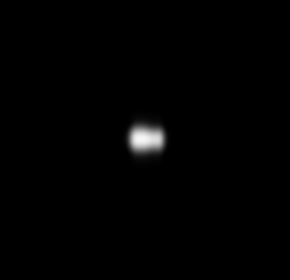 | |
| Discovery | |
|---|---|
| Discovered by | Mark R. Showalter and Jack J. Lissauer |
| Discovery date | August 25, 2003 |
| Designations | |
Designation | Uranus XXVII |
| Pronunciation | /ˈkjuːpəd/ |
| Adjectives | Cupidian /kjuːˈpɪdiən/[1] |
| Orbital characteristics | |
| 74,392 km | |
| Eccentricity | 0.0013 |
| 0.618 d | |
| Inclination | 0.1° (to Uranus' equator) |
| Satellite of | Uranus |
| Physical characteristics | |
Mean radius | 8.9±0.7 km[4] |
| ~1,000 km2 | |
| Volume | ~3,000 km3 |
| Mass | ~(1.5–3.5)×1015 kg |
Mean density | 0.5–1.2 g/cm3[5] |
| ~0.0013–0.0029 m/s2 | |
| ~0.0047–0.0072 km/s | |
| synchronous | |
| 0 | |
| Albedo | 0.08 (assumed)[2] |
| Temperature | ~64 K |
Cupid is an inner satellite of Uranus. It was discovered by Mark R. Showalter and Jack J. Lissauer in 2003 using the Hubble Space Telescope.[6] It was named after a character in William Shakespeare's play Timon of Athens.[7]
It is the smallest known inner Uranian satellite (apart from possibly Mab), crudely estimated to be only about 18 km in diameter. This and the dark surface made it too dim to be detected by the Voyager 2 cameras during its Uranus flyby in 1986.
The orbit of Cupid differs only by 863 km from the orbit of the larger moon Belinda. Unlike Mab and Perdita, Uranian satellites also discovered in 2003, it does not seem to be perturbed.[2] Despite this, it has the least stable orbit of Uranus's inner moons — it is likely to collide with Belinda in the next 100,000–10 million years, due to resonance interactions that cause the smaller Cupid to drift into a more dangerous orbit over this timescale.[5]
Cupid is at most 500 million years old.[3]
Following its discovery, Cupid was given the temporary designation S/2003 U 2.[6] It is also designated Uranus XXVII.[7]
It should not be confused with the asteroid 763 Cupido.
YouTube Encyclopedic
-
1/5Views:369390 18323 766 7291 712 5911 278
-
Zooming In on Cupid!
-
What would it be like to live on the moon?
-
"Outer Space" - StoryBots Super Songs Episode 1 | Netflix Jr
-
The myth of the moon goddess - Cynthia Fay Davis
-
To all the creators 🤡🫶 #cupid #fiftyfifty #edit
Transcription
References
- ^ Tanner; Barnet (1995). Comedies.
- ^ a b c Showalter, Mark R.; Lissauer, Jack J. (2006-02-17). "The Second Ring-Moon System of Uranus: Discovery and Dynamics". Science. 311 (5763): 973–977. Bibcode:2006Sci...311..973S. doi:10.1126/science.1122882. PMID 16373533. S2CID 13240973.
- ^ a b Ćuk, Matija; French, Robert S.; Showalter, Mark R.; Tiscareno, Matthew S.; Moutamid, Maryame El (2022-07-16). "Cupid is not Doomed Yet: On the Stability of the Inner Moons of Uranus". The Astronomical Journal. 164 (2): 38. arXiv:2205.14272. doi:10.3847/1538-3881/ac745d. ISSN 1538-3881.
- ^ Showalter & Lissauer (2006),[2] as cited in Ćuk et al. (2022).[3]
- ^ a b French, Robert S.; Showalter, Mark R. (August 2012). "Cupid is doomed: An analysis of the stability of the inner uranian satellites". Icarus. 220 (2): 911–921. arXiv:1408.2543. Bibcode:2012Icar..220..911F. doi:10.1016/j.icarus.2012.06.031. S2CID 9708287.
- ^ a b Showalter, Mark R.; Lissauer, Jack J. (September 25, 2003). "S/2003 U 1 and S/2003 U 2". IAU Circular. 8209: 1. Bibcode:2003IAUC.8209....1S. ISSN 0081-0304. Retrieved 2011-11-02.
- ^ a b "Planet and Satellite Names and Discoverers". Gazetteer of Planetary Nomenclature. USGS Astrogeology. July 21, 2006. Retrieved 2006-08-05.
External links
- Hubble Uncovers Smallest Moons Yet Seen Around Uranus – Hubble Space Telescope news release (25 September 2003)


